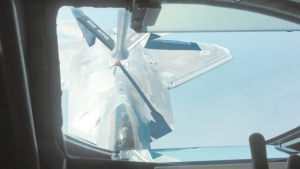VIDEO -- Pulling back the curtain: Taking a flight in a KC-135
By Melinda Harrell
Published in News on May 18, 2017 12:59 PM

News-Argus/JOEY PITCHFORD
For Master Sgt. Kenny Fallin, another day at the office means flying 21,000 feet with 100,000 pounds of jet fuel under his feet.
With an amiable smile, a few jokes and an exuberance for his work, Fallin explained exactly what a refueling mission entails as he maneuvered an extender from the back of a KC-135 to connect with an F-15E Strike Eagle Wednesday.
Fallin, who has served in the Air Force for 28 years, deftly refuels F-15Es and F-22s in flight with only 30 feet separating the KC-135 from the fighter jets, making a complex and skill-demanding job seem almost effortless.
Various media outlets were invited to take a ride on the KC-135 on the front end of the 2017 Wings Over Wayne Air Show to detail exactly what the aircraft and the 916th Refueling Wing are capable of before the aircraft goes on display for thousands to see on Saturday and Sunday.
As the aircraft took off from the base, the KC-135 climbed from 6,000 to 10,000 to 17,000 to 21,000 feet.
In the cockpit, Fallin, while sitting at a work area just behind the pilots, said that the crew is told ahead of time at what altitude it is to fly and "we maintain that altitude, we'll go up to 21,000 feet today."
From take-off, Fallin is constantly recording the operation and once the KC-135 reaches its appropriate altitude he hustles to the back of the aircraft to operate the boom, or the refueling extender.
Tech Sgt. Andrew Stueart also manned the boom a bit and before take-off prepped the passengers for what to expect -- a task that is atypical on any other given day.
Stueart said that refueling operations on a day-to-day level are done by reservists at Seymour Johnson, most being part-time and some full-time.
"Our primary job is to refuel other aircraft in flight," he said.
The KC-135 has bunks near the back of the fuselage that allows for a crew to sleep, said Stueart because sometimes missions can be lengthy -- up to 24 hours.
"The longest I have been on is 14 hours," he said.
"But we are doing something good. There is no better way to spend our time than by doing something good."
